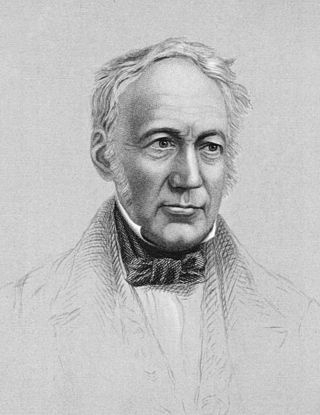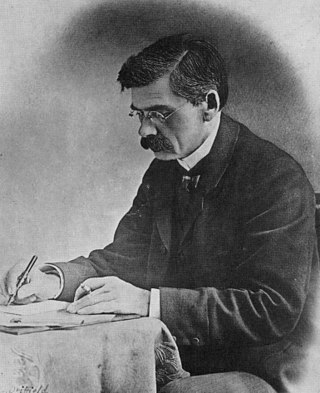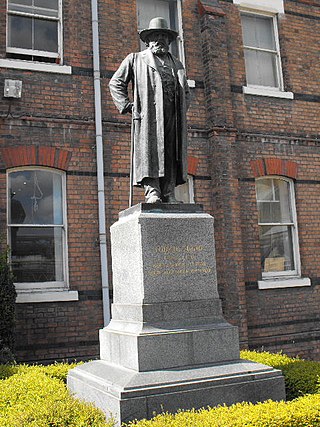Related Research Articles

Sir Frederick Augustus Abel, 1st Baronet was an English chemist who was recognised as the leading British authority on explosives. He is best known for the invention of cordite as a replacement for gunpowder in firearms.

The chemical industry comprises the companies and other organizations that develop and produce industrial, specialty and other chemicals. Central to the modern world economy, it converts raw materials into commodity chemicals for industrial and consumer products. It includes industries for petrochemicals such as polymers for plastics and synthetic fibers; inorganic chemicals such as acids and alkalis; agricultural chemicals such as fertilizers, pesticides and herbicides; and other categories such as industrial gases, speciality chemicals and pharmaceuticals.
The Leblanc process was an early industrial process for making soda ash used throughout the 19th century, named after its inventor, Nicolas Leblanc. It involved two stages: making sodium sulfate from sodium chloride, followed by reacting the sodium sulfate with coal and calcium carbonate to make sodium carbonate. The process gradually became obsolete after the development of the Solvay process.

Ludwig Mond FRS was a German-born, British chemist and industrialist. He discovered an important, previously unknown, class of compounds called metal carbonyls.
Robert Angus Smith FRS was a Scottish chemist, who investigated numerous environmental issues. He is known for his research on air pollution in 1852, in the course of which he discovered what came to be known as acid rain. He is sometimes referred to as the 'Father of Acid Rain'.

Andrew Ure FRS was a Scottish physician, chemist, scriptural geologist, and early business theorist who founded the Garnet Hill Observatory. He was a fellow of the Royal Astronomical Society and the Royal Society. Ure published a number of books based on his industrial consulting experiences.

Sir Isaac Lowthian Bell, 1st Baronet, FRS was a Victorian ironmaster and Liberal Party politician from Washington, County Durham, in the north of England. He was described as being "as famous in his day as Isambard Kingdom Brunel".

James Muspratt was a British chemical manufacturer who was the first to make alkali by the Leblanc process on a large scale in the United Kingdom.
Alkali manufacture is the process by which an alkali is made. Typical alkalis, produced commercially, include sodium hydroxide, sodium carbonate, potassium hydroxide and potassium carbonate.

Charles Tennant was a Scottish chemist and industrialist. He discovered bleaching powder and founded an industrial dynasty.
United Alkali Company Limited was a British chemical company formed in 1890, employing the Leblanc process to produce soda ash for the glass, textile, soap, and paper industries. It became one of the top four British chemical companies merged in 1926 with Brunner Mond, Nobel Explosives and British Dyestuffs Corporation to form Imperial Chemical Industries.

Ferdinand Hurter was a Swiss industrial chemist who settled in England. He also carried out research into photography.

William Gossage was a chemical manufacturer who established a soap making business in Widnes, Lancashire, England.

Henry Deacon was a chemist and industrialist who established a chemical factory in Widnes, Lancashire, England.
Edmund Knowles Muspratt was an English chemical industrialist.
Carl Gustav Guckelberger was a German chemist.

Sir George Thomas Beilby was a British chemist.

The Statue of Ludwig Mond stands outside the entrance to Mond House in Brunner Mond Works, Winnington, Cheshire, England. Ludwig Mond was born in Germany but spent most of his working life in England. He moved to England in 1862 and joined the business of John Hutchinson in Widnes. Wishing to develop a better process for the production of alkali than the Leblanc process, he joined in partnership with John Brunner, who also worked for Hutchinson, to improve the ammonia-soda process, building a factory for this purpose at Winnington. In time the factory became the largest producer of soda in the world. Mond went on to work with other chemical processes, especially those involving nickel. He also became an art collector, bequeathing much of his collection to the nation. His statue was designed by Édouard Lantéri, and was unveiled by Brunner in 1913. It was moved in 1995 to stand next to the statue of Brunner in front of the offices of Brunner Mond in Winnington. The statue is recorded in the National Heritage List for England as a designated Grade II listed building.
John FergusonFRSE LLD was a Scottish chemist and bibliographer. He is noted for the early alchemy and chemistry bibliography Bibliotheca chemica. He was generally nicknamed Soda Ferguson. The Ferguson Collection, a collection of 7,500 books and manuscripts from his personal library is held by the University of Glasgow.

St Rollox Chemical Works was a industrial manufacturer of chemicals located in Glasgow, Scotland, that began in the Georgian era in 1799 and operated continuously until 1964. It was owned and operated by Scottish industrialist Charles Tennant and was described as the largest plant in Europe, if not the world.
References
- 1 2 3 4 5 6 7 8 9 10 11 "Obituary. James Mactear, 1845-1903". Minutes of the Proceedings of the Institution of Civil Engineers. 154 (1903): 378–379. January 1903. doi:10.1680/imotp.1903.18039.
- ↑ Mactear, James (19 November 1880). "A new mechanical furnace, and a continuous system of manufacturing sulphate of soda". Journal of the Society of Arts. 29: 178.
- ↑ Russell, Colin Archibald; Britain), Royal Society of Chemistry (Great (2000). Chemistry, Society and Environment: A New History of the British Chemical Industry. Royal Society of Chemistry. p. 82. ISBN 978-0-85404-599-0.
- ↑ Reed, Peter (23 March 2016). Acid Rain and the Rise of the Environmental Chemist in Nineteenth-Century Britain: The Life and Work of Robert Angus Smith. Science, technology, and culture, 1700-1945 (1st ed.). London: Routledge. p. 148. ISBN 978-1-317-18582-6.
- ↑ "Unpublished letter, 'Artifically [sic] formed diamonds' from James Mactear to the Secretary of the Royal Society". The Royal Society. London: The Royal Society Archives. 14 December 1879. Retrieved 2 November 2023.
- ↑ Official Catalogue of the British Section of the Vienna Universal Exhibition 1873 (2nd ed.). London: J.M. Johnson and Sons. 1873. p. 11.
- ↑ Wisniak, Jaime (November 2001). "The History of Iodine from Discovery to Commodity" (PDF). Indian Journal of Chemical Technology. Department of Chemical Engineering, Ben-Gurion University of the Negev. 8: 518–526.
- ↑ Allen, John Fenwick (1906). "Christian Allhusen.". Some Founders of the Chemical Industry: Men to be Remembered. Sherratt & Hughes. pp. 231–248.
- ↑ Irving, Joseph (1881). The Book of Scotsmen Eminent for Achievements in Arms and Arts, Church and State, Law, Legislation, and Literature, Commerce, Science, Travel, and Philanthropy. Paisley: A. Gardner. p. 381.
- ↑ Reed, Peter (23 March 2016). Acid Rain and the Rise of the Environmental Chemist in Nineteenth-Century Britain: The Life and Work of Robert Angus Smith. Science, technology, and culture, 1700-1945 (1s ed.). London: Routledge. p. 148. ISBN 978-1-317-18582-6.
- ↑ Spiers, Edward M. (1980). The Army and society, 1815-1914. London New York: Longman. pp. 163–168. ISBN 0-582-48565-7.
- ↑ Grierson, J. M. (1909). The Records of the Scottish Volunteer Force 1859 to 1908 (PDF). Edinburgh: William Blackwood and Sons. p. 255.
- ↑ MacTear, James (17 May 1878). "Some Recent Improvements in the Process Connected with Alkali Manufacture". Journal of the Royal Society of Arts: 988.